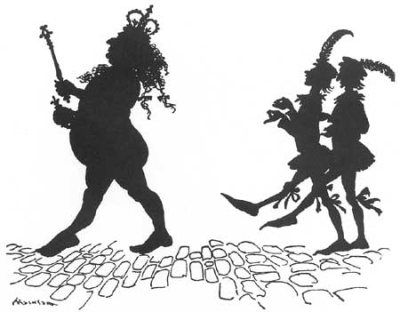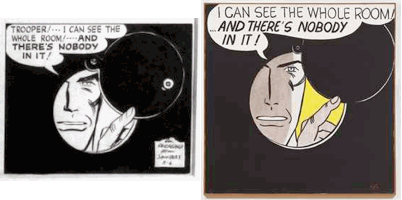
In a 2006 post titled "Lichtenstein the Ingrate," I bemoaned Roy Lichtenstein's elitism. I explained that I was bothered less by the famous artist's "questionable sampling" of newspaper and comic book artists' work than I was by his disregard for the skill of those he copied. In a 1963 interview, Lichtenstein distinguished between his source material and his paintings.
"What I do is form, whereas the comic strip is not formed in the sense I'm using the word; the comics have shapes but there has been no effort to make them intensely unified...The difference is often not great, but it is crucial."Throughout my late teens and twenties, Lichtenstein's comic-inspired artworks inflamed my sense of righteous indignation. I don't get especially worked up about Lichtenstein's appropriation anymore, but I still believe the man was a charlatan. Had he acknowledged his indebtedness to the artists he imitated, his comic panel paintings could be interpreted as a cynical project highlighting the role of class and money in the appraisal of culture (i.e., it's not fine art if it's in a newspaper, but if it's in a gallery and the "right" person will pay a lot of money for it, it is). That still wouldn't make it particularly thoughtful artwork, but Lichtenstein could have been remembered as a winking champion of the comic artists that nourished him.

Right: Lichtenstein's rendition
In 2006, I believed that Lichtenstein was "turning into a cultural blip." I took comfort in that presumption, but it's no longer so clear to me that Lichtenstein will be forgotten. A recent ArtInfo article by Judd Tully compares last month's Christie's auction sales price of Lichtenstein's "I Can See The Whole Room!...And There's Nobody In It!" to the EBay auction sales price, last August, of the William Overgard artwork that was the source of Lichtenstein's painting. The former sold for $43,202,500; the latter, for $431. According to the art market, then, the Lichtenstein version is worth more than 100,000 times what the Overgard original is worth! Sure, Lichtenstein's is a bigger picture, but the enormity of the price difference is testament to the intangibles in play in the art market. I love looking at, writing about, and making art, but contemplation of the art market is a depressing affair.
Image credit: "The Emperor's New Clothes" illustration, ripped from My Fresh Plans site (illustrator uncredited); Overgard and Lichtenstein reproductions "appropriated" from The Daily Cartoonist

No comments:
Post a Comment